As you might remember, i recently took the train to Liverpool to see the exhibition Robots and Avatars, conceived by design collective body>data>space and FACT.
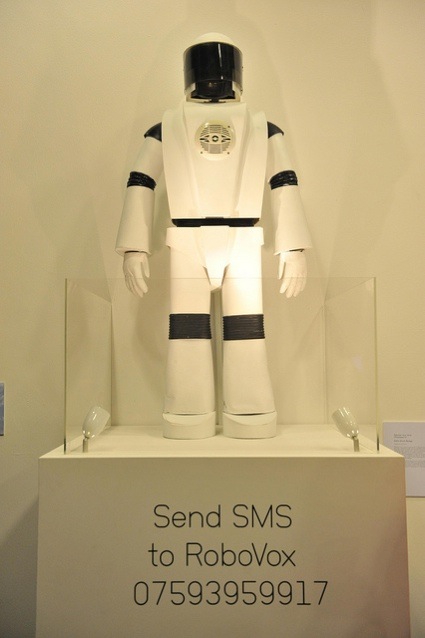 Martin Bricelj Baraga, RoboVox, 2006. Photographer: Brian Slater
Martin Bricelj Baraga, RoboVox, 2006. Photographer: Brian Slater
Robots and Avatars invites visitors to imagine what will happen in a -not so distant- future when the advance of technology will bring us in even closer contact with artificial intelligence and machines. Will we have to re-assess what we now define as ‘life’ and as ‘body’? How do we envisage our future relationships with robotic and avatar colleagues and playmates, and what point does this evolution cross our personal boundaries of what it is to be a living, feeling human being?
As a kind of introduction to the issue, the documentary ROBOT WORLD gives the state of the art of robotics by compiling films from university labs, private footage taken at industrial fairs, military archives, corporate videos and extracts from 1930’s movies.
Martin Hans Schmitt, Robot World – A Meeting with Your Alternate Double, 2010 (trailer)
But the spectrum of the exhibition’s enquiry is much broader than the documentary. Some of the works exhibited demonstrate how much the artificial imitates human life. Others speculate on how radically it might depart from it. The show leads the visitor from Second Life to invisible architecture, from the familiar to the unexpected and even sometimes to foreign territories. From the physical body to the digital body and back again.
I’ve already blogged about some of the works exhibited in the past (namely Compass, rep.licants.org and ADA) so i’ll just mention a few works you might find interesting:
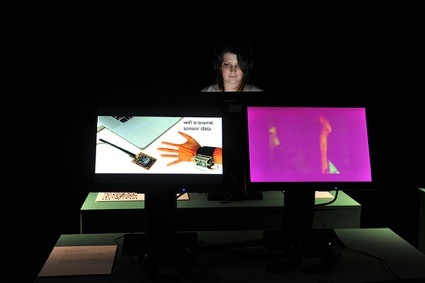 Shu Lea Cheang and Co, UKI, 2011. Photographer: Brian Slater
Shu Lea Cheang and Co, UKI, 2011. Photographer: Brian Slater
The most thought-provoking and exciting work for me was UKI by Shu Lea Cheang. UKI is a sequel to her 2000 cyberpunk movie I.K.U. The film is set in 2030 and explores whether the replicants of Blade Runner have sex. In 2030, the GENOM corporation is selling orgasms on portable devices and sending a shapeshifter coder out into New Tokyo to collect “orgasm data”.
UKI is a live coding / live spam performance where software and body viruses are merging but also a viral game that is presented at FACT on two screens.
![]() Photographer: Brian Slater
Photographer: Brian Slater
About the time of the opening of the exhibition, an actor was playing Public Avatar in the streets of Liverpool. People anywhere in the world could login on the website of the project, instruct the avatar to do simple tasks and follow his whereabouts in the city. This project explores the borders between virtual and real and tests the limits of human machine control.
![]() Martin Bricelj and Slavko Glamočanin, Public Avatar, 2009. Image courtesy of Martin Bricelj
Martin Bricelj and Slavko Glamočanin, Public Avatar, 2009. Image courtesy of Martin Bricelj
Base 8 is inspired by Pepper’s Ghost , a 19th century illusionary technique that makes objects seem to appear or disappear or make one object seem to morph into another. In the version designed by Chris Sugrue however, the illusion is that of a floating colony of small creatures coming to life around and in between your fingers and hands.
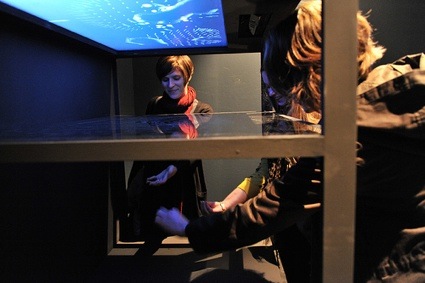 Chris Sugrue, Base 8, 2011. Photographer: Brian Slater
Chris Sugrue, Base 8, 2011. Photographer: Brian Slater
More images from the show:
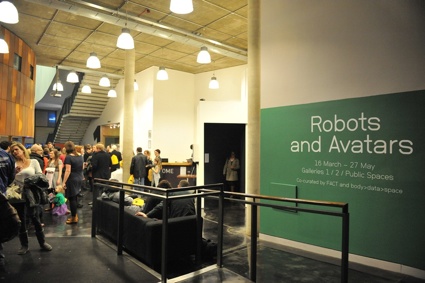 Opening of the exhibition. Photographer: Brian Slater
Opening of the exhibition. Photographer: Brian Slater
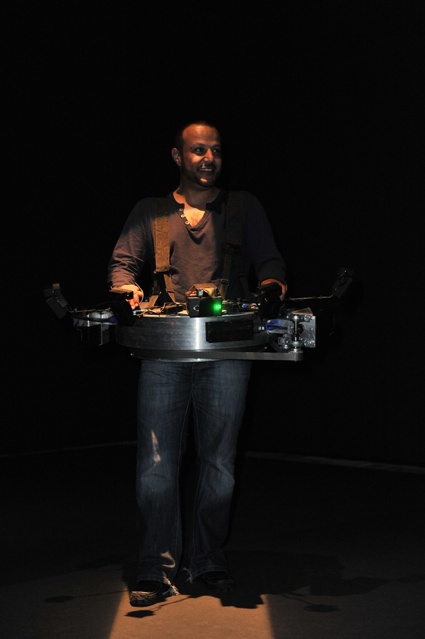 Lawrence Malstaf, Compass, 2005. Photographer: Brian Slater
Lawrence Malstaf, Compass, 2005. Photographer: Brian Slater
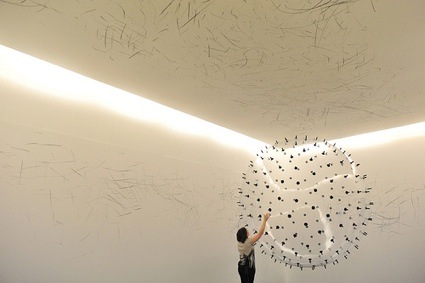 Karina Smigla-Bobinski, ADA, 2010. Photographer: Brian Slater
Karina Smigla-Bobinski, ADA, 2010. Photographer: Brian Slater
Robots and Avatars remains open at FACT (Foundation for Art and Creative Technology), Liverpool until 27 May 2012. The exhibition will then travel to AltArt, Cluj-Napoca (Romania) and KIBLA (Slovenia) in 2012.
The Robots and Avatars exhibition in the UK is co-produced in the UK by body>data>space and FACT in collaboration with the National Theatre. European co-organisers are KIBLA (Maribor/Slovenia) and AltArt (Cluj Napoca/Romania). With the support of the Culture programme of the European Union, this project was conceived by lead producer body>data>space in association with NESTA.
